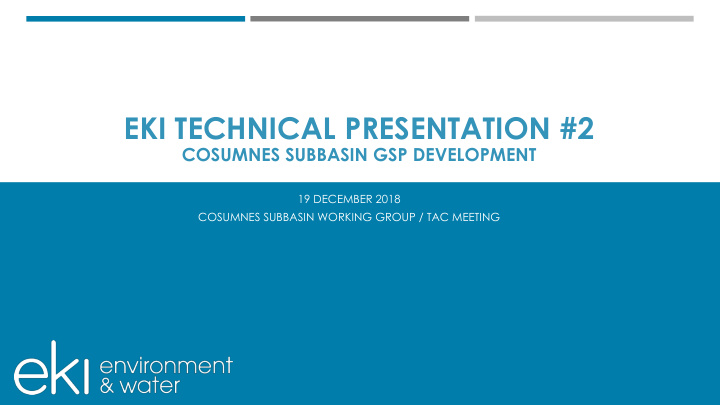



EKI TECHNICAL PRESENTATION #2 COSUMNES SUBBASIN GSP DEVELOPMENT 19 DECEMBER 2018 COSUMNES SUBBASIN WORKING GROUP / TAC MEETING
AGENDA ITEM #1 GENERAL UPDATES
TSS GRANT Amador submitted for two monitoring wells DWR indicated at ACWA that they have only receive eight requests to date
DATA REQUEST FORMS Basin Stakeholders Introductory letter Stakeholder Survey Data Request Form Basin Public Water Suppliers Introductory letter Need missing PWS contact info GSA responsible for mailing
ESJ GWA 11/14 MEETING SUMMARY Updates on Projects & Management Actions Nine new projects added since last month: 3 Surface water supply, 3 recharge, 1 recycling/recharge, 2 supply assessments Project Review Project & Management Actions will be used to meet “overdraft” of Basin Projects will be reviewed based on advisory committee criteria: Implementability, location/proximity to area of overdraft, cost per volume water savings, environmental benefit/impact, Disadvantage Community benefit, water quality impact Update on Water Quality Minimum Thresholds, Monitoring Network Focus moving away from monitoring salinity “front” and shift toward uniform water quality criteria Recommended Minimum Threshold of 600 mg/L Total Dissolved Solids (Basin-wide) TSS Funding Update Proposing selection of ~ 3 wells to propose for funding
AGENDA ITEM #4 DATA MANAGEMENT SYSTEM DECISION
DATA MANAGEMENT SYSTEM (DMS) EVALUATION TM#1 submitted to TAC/Working Group in November 2019 DMS discussed in detail during TAC/Working Group Webinar on 19 November 2018 EKI responded to two follow up questions in email dated 3 December 2018 Relative cost Web-based interface
SIMPLE, CUSTOM DMS IS RECOMMENDED The Working Group will be The DMS options were evaluated against the following criteria: responsible for maintaining their system and submitting the SGMA GSP Regulations; information as part of GSP submission and annual reporting. DWR BMP Guidance; Public Availability; Common Use; Adaptability; Web Data Interface; and, Cost-Effectiveness.
AGENDA ITEM #5 GROUNDWATER MODELING
GROUNDWATER MODEL EVALUATION Numerical Model evaluations discussed during multiple TAC/Working Group Meetings February 2018 September 2018 October 2018 Ranking criteria and weighting reviewed during TAC/Working Group webinar on 19 November 2018 TM#3 submitted to TAC/Working Group in December 2019
SIX MODELS EVALUATED 1. California Central Valley Groundwater-Surface Water Simulation Model Fine-Grid (C2VSim-FG); 2. Central Valley Hydrologic Model (CVHM); 3. Sacramento Valley Groundwater-Surface Water Simulation Model (SVSim); 4. Sacramento Area Integrated Water Resources Model (SacIWRM); 5. A custom, stand-alone model developed for the Cosumnes Subbasin; and 6. A custom, nested model developed for the Cosumnes Subbasin.
Sept. 2019
MODEL CRITERIA Ranked Criteria Pass / Fail Criteria (Weighted and Unweighted) Release Date - The model needs to be available Following criteria listed in order of importance to support Cosumnes Subbasin GSP recommended by GSA representatives during 19 development; November 2019 webinar: 1. Represents Hydrogeological Conceptual Model Model Capability - The model must be able to (HCM) accepted by Working Group and employed support water budget development, Sustainable for Cosumnes Subbasin GSP; Management Criteria (SMC) development, and evaluation of Project and Management Actions 2. Supports coordination with adjacent basins and regional water supply planning (e.g., groundwater (P&MAs), among other items necessary for GSP banking); development; and 3. Minimum cost for future maintenance, Budget – The model development/update must implementation, and adaptive management; be able to be achieved within the available budget. 4. Working Group is primary decision maker; and 5. Schedule allows Working Group opportunity to provide input to model development/update.
MODEL RANKING – EQUAL WEIGHTING
MODEL RANKING WEIGHTED CRITERIA
CUSTOM NESTED MODEL BEST MEETS CRITERIA Best meets Working Group needs for GSP development and implementation Based on the Hydrogeological Conceptual Model developed for the GSP and accepted by the Working Group A nested model improves the subbasin’s representation in the regional model, and therefore supports coordination with adjacent basins and areas. (i.e. groundwater banking projects) Model will be custom made for the GSA and makes GSAs the primary decision makers (e.g., model objectives, schedule, cost, acceptance criteria)
NEXT STEPS FOR MODEL SELECTION AND GSP DEVELOPMENT Working Group approval to finalize model selection (January 2019 WG/TAC Meeting) Monitor development and release of regional models and select best option for nested model Compile available data into the DMS Develop Hydrogeological Conceptual Model
AGENDA ITEM #6 GSP DEVELOPMENT SCHEDULE REVIEW
REMAINING PHASES (April 2019 – April 2020) (April 2020 – April 2021) (April 2021 – February 2022) Phase 3: Phase 2: Basin Phase 4: GSP Sustainability Characterization Preparation and Planning and Analysis Submittal • Focuses on technical • Focuses on planning • Preparation of the GSP analysis of Basin for the sustainable and associated conditions. management of the deliverables for use by • Hydrogeologic basin Basin GSAs in adopting • Sustainability Criteria conceptual model the GSP, with • Groundwater • Monitoring subsequent submittal to conditions DWR • Projects & • Water Budget Management Actions 21
Recommend
More recommend